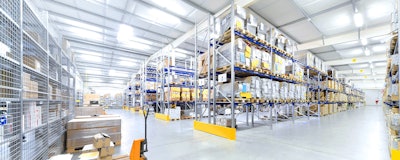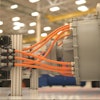
 Steve Adams
Steve AdamsLet’s face it, warehousing of product in essence should be relatively simple. The product is received, putaway, picked and then shipped with an occasional count to make sure everything is in order.
However the consequence of an inefficient and ineffective warehouse can be disastrous. Product that is built to exacting specifications in your pristine manufacturing operation that disappears in a warehouse “black hole” is never going to impress any customers. Bottom line, if you can’t find the product, you can’t ship it, or if it takes longer in labor costs to find it than the customer paid for it, then your chance of a long term profitable business are very slim. Your business is the sum of all parts and unfortunately the lowest common denominator usually thrives.
Done well though, warehousing can make your business thrive and give you a competitive advantage in the industry.
The question therefore is, “What makes one warehouse more efficient than any other?" There are many answers to this question, but some of the more obvious are people, process, storage and material handling equipment and systems, to mention just a few.
Nowadays many companies have a Warehouse Management System (WMS) to help them manage all the people and processes within a warehouse. While a WMS can help control the movement and storage of materials within a warehouse and process associated transactions, such as receiving, picking and shipping, even when used well, there are still many “hidden costs” that can have a major impact on the bottom line, customer satisfaction and overall business success.
Here are three “hidden costs” that can be addressed with proper use of a WMS.
Time
Travel time is the second most expensive variable cost, labor being the first. It is virtually invisible and extremely expensive if allowed to go unchecked. Just as a manager would not want to see employees wandering around with nothing to do, equipment should not be crossing the floor unloaded, or traveling to the far corners of the warehouse to pick the product when the same product is available within eyesight. Three solutions available with WMS can resolve this issue.
Slotting is the placement of products within a warehouse facility, to maximize the use of a warehouse’s available cube space by improved storage and picking efficiency and reductions in warehouse handling cost, by optimizing product location and balancing workload. This strategy takes a number of factors into consideration, such as location, dimensions and weight, to profile and sequence items down the pick path. Proper slotting leads to reduced picker travel, more stable loads, fewer accidents and less product breakage.
Interleaving is a practice that uses WMS to assign tasks to workers in ways that make use of each trip that they and their associated equipment make during their work shifts. This practice typically can eliminate 25 to 30 percent of the machine travel associated with pallet moves.
Picking strategies are one of the easiest and more cost effective ways to maximize productivity and improve order accuracy. This operation is also in direct connection to customer satisfaction, as quickly and accurately processing orders is essential to the bottom line. Batch picking involves picking more than one order at a time. Using the WMS to help batch orders together in different ways, allows the workers to optimize picks and increase pick density, which reduces the number of times a picker has to travel through any aisle. Zone picking divides the warehouse into multiple zones and assigns workers to pick only within one zone reducing travel time. Orders are either picked and passed from zone to zone for fulfillment or consolidated at a point before shipping. Order picking is often the most preferred method of picking, but may not be the most effective. An order picker picks one order at a time, following a route up and down each aisle until the entire order is picked. This method may work well in an operation with a low number of orders, and a high number of picks per order; however, using this method in a warehouse with a large number of smaller orders would lead to excessive travel time.
Inventory
Inventory management is a balancing act. You can’t have too much, which could lead to shelves filled with expired or obsolete products; excessive expensive inventory holding or a larger facility than is really needed. You don’t want too little, resulting in product shortages, unfulfilled orders and unhappy customers. You need just the right amount of stock. Companies can increase profitability 20 to 50 percent through careful inventory management.
Tracking inventory is essential. Product should be tracked and recorded during initial receipt, as bad practices at receiving only get worse later. Whether it is through the use of bar codes or radio frequency identification (RFID), a detailed transaction history of inventory flowing in and out of the warehouse can improve visibility and reduce errors. Real-time data in WMS means the system and the warehouse are never out of sync, ensuring better checks and balances with audits and cycle counts.
Shelf life and stock rotation can also have a major “hidden cost” implication. Not every company has to worry about this, but when they do SKU accuracy by location is not enough. Warehouses need to now know where each lot is stored and when and if the product is set to expire. Most Warehouse Management Systems offer various controls to help control the shipping of these products, such as LIFO, FEFO and FIFO. Without these controls product will expire without ever being picked. The costs associated with this can be outstanding. There is the obvious cost of the manufacturing of these obsolete products but also expensive warehouse space has been used to house the product and costly labor to receive and putaway the product can also be incurred with no payback.
Organization
The final area of “hidden” costs is the organization of the warehouse itself. Cost savings in travel time and inventory control can be lost if the warehouse is an incomprehensible maze. The first step is to determine how the facility will operate and develop a master strategy. Decide how space is used and think in three dimensions; rather than expanding the footprint, perhaps there can be better use of vertical space. Examine potential traffic patterns and storage locations. Consider how items will be picked, how they will be putaway and how the stock will be replenished. Group products into families based on the results of this analysis, and configure the WMS to support this plan, building in exception protocols. Lastly, plan to work and work the plan. Without regular upkeep, a well-organized warehouse can quickly become disorganized and difficult to navigate.
Conclusion
Remember, warehouses should never be rocket science. Having a strong WMS will help reduce costs, increase inventory accuracy and storage capacity and improve customer satisfaction. This will at least allow you to survive against your competitors. Using a strong WMS effectively to manage all processes will help you drive out these additional “hidden costs”, giving you a tangible advantage against your competitors.
Today’s economy is very challenging and the difference between surviving and thriving, means knowing about every part of your business and operation in detail. Many of the most successful companies in today’s world aren’t successful because they make better and more innovative products, they just bring other companies products to the market in the most cost effective and efficient manner. They understand that an extra 10 seconds on every pick can cost millions when repeated many thousand times a day. If they haven’t resolved all their “hidden costs”, I’m sure they at least know where most of them are and have a plan to fix them.
Steve Adams is director of Catalyst at Aptean.























